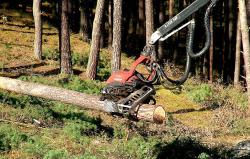 Wydawca treści
Wydawca treści
Forest Use
 Głowica ścinkowa. Fot. Michał Szczepaniak
Głowica ścinkowa. Fot. Michał Szczepaniak
 Wycinka. Fot. Michał Szczepaniak
Wycinka. Fot. Michał Szczepaniak
 Stos surowca drzewnego przygotowanego do wywozu. Fot. Archiwum Nadleśnictwa
Stos surowca drzewnego przygotowanego do wywozu. Fot. Archiwum Nadleśnictwa
In accordance with the principles of sustainable forest economy, apart from activities aimed at protection and enhancement of forest resources implemented by Lipinki Forest District Inspectorate, forest use makes another important area of its activity. It includes both, works connected with acquiring of timber (estimating its amounts and types, timber cutting and logging and its transport from the woods) and other related raw material such as Christmas trees or branches used for decoration.
Forests maintained for industrial purposes located within Lipinki Forest District are the main source of timber for industry and cover the area of nearly 13 000 ha. The average annual amount of large timber acquired in the Forest District amounts to 90 000 m3.
Major timber types acquired within the Forest District are: large-size timber (sawmill timber), middle-size timber (pulpwood), small-size timber (slash) and timber for fuel, which can be acquired by customers for their own use in places specified by the Forest District Inspectorate.
Amounts of acquired timber depend on annual plans of forest felling and pre-felling works. Pre-felling works performed in 2013 in Lipinki Forest District supplied over 50 000 m3 of timber and felling works supplied about 44 500 m3 of timber. Most of the timber has been obtained from coniferous trees, such as Pine and Spruce, and broadleaf trees, such as Birch, Oak and Aspen.
Apart from timber acquisition as part of forest management plans, Lipinki Forest District Inspectorate also implements the so-called auxiliary use that involves annual acquisition and sale of a small number of Christmas trees and branches used for decoration and acquisition of bark from a bush called Alder Buckthorn (as requested by pharmaceutical companies).













